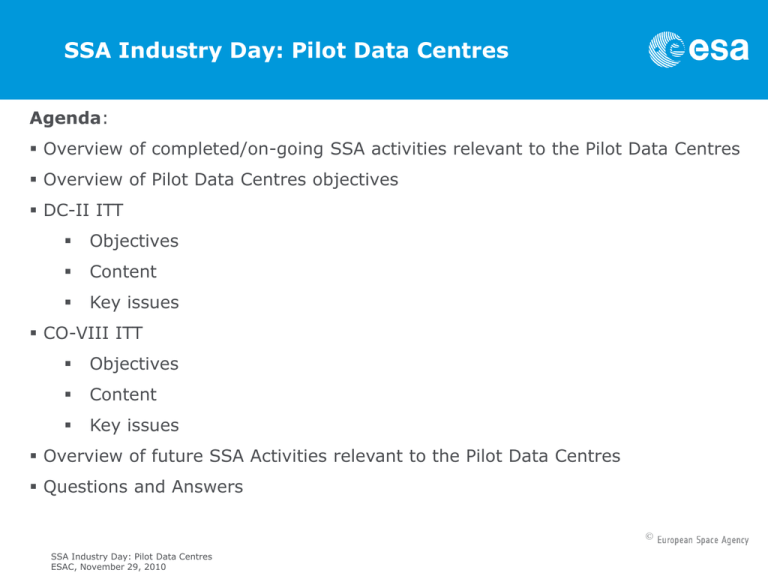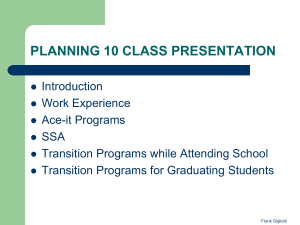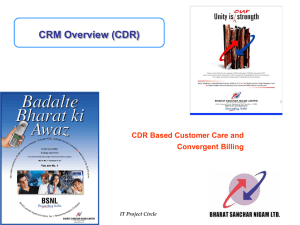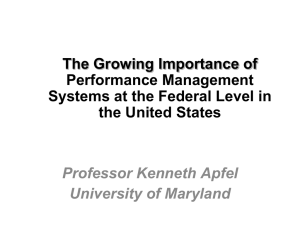SSA Industry Day: Pilot Data Centres - Emits
advertisement

SSA Industry Day: Pilot Data Centres Agenda: Overview of completed/on-going SSA activities relevant to the Pilot Data Centres Overview of Pilot Data Centres objectives DC-II ITT Objectives Content Key issues CO-VIII ITT Objectives Content Key issues Overview of future SSA Activities relevant to the Pilot Data Centres Questions and Answers © SSA Industry Day: Pilot Data Centres ESAC, November 29, 2010 Overview of Completed/On-going SSA Procurements Tasking Centre SST Space Surveillance & Tracking Centre NEO Near Earth Objects Centre SWE Space Weather Centre © SSA Industry Day: Pilot Data Centres ESAC, November 29, 2010 Overview of Completed/On-going SSA Procurements SSA Preparatory Programme is divided into 4 elements which each have a different set of participating member states: • Core (CO): system definition and SST segment precursors • Space Weather (SN): SWE and NEO segments precursors • Radar (RR): surveillance radar breadboard • Pilot Data Centres (DC): • prepare the data centres, • expand/extend the precursors applications/services in each segment, • initiate the Tasking Centre activities, • use real data sources, • prototype the end-to-end system. © SSA Industry Day: Pilot Data Centres ESAC, November 29, 2010 Overview of Completed/On-going SSA Procurements SSA Preparatory Programme has two distinct parallel development paths: 1) defining the complete future SSA system, i.e. both the space and the ground segments. It includes the definition of the system requirements and the overall system architecture. In addition, it shall also define the underlying governance and data policy required for managing the sensitive data of the system. 2) rolling out SSA Precursor Services (ie. a few representative and essential SSA services) by re-using and federating existing assets in Europe (e.g. expertise, applications, sensors) including those of ESA. The Precursor Services shall help in federating the SSA user community and shall help in getting practical experience in providing SSA services in the three SSA domains. This experience shall be fed back into the first development path. © SSA Industry Day: Pilot Data Centres ESAC, November 29, 2010 Completed SSA Procurements relevant to the Pilot Data Centres • CO-I part I (two parallel contracts; both completed): Study of optical surveillance of LEO to complement surveillance radar input to overall SSA architecture definition activities (see CO-I part II and CO-II) • CO-III (in final review): Comparison of several Service Oriented Architecture (SOA) frameworks available as COTS. A series of prototype cases relevant to SSA were implemented under each candidate SOA framework. ESA is now awaiting offers from two of the SOA framework vendors for a Frame Agreement that would cover SSA activities for at least the next 10 years. The final decision should be made before the end of the year. © SSA Industry Day: Pilot Data Centres ESAC, November 29, 2010 On-going SSA Procurements relevant to the Pilot Data Centres • CO-I part II (completion in spring 2011): Overall requirements and architecture to the SRR level. Makes use of ESA’s Concurrent Design Facility. • CO-IV (just completed CDR): Antenna arrays and processing study plus a full radar simulator. • CO-V (two parallel contracts; at CDR): Telescope architecture, space-based telescopes, and sensor tasking simulation. • CO-VI (mid-point): SST precursor services implementation. Main service is a re-deployment for SSA of ESA’s collision avoidance system called CRASS. Also develops a data model for SST. © SSA Industry Day: Pilot Data Centres ESAC, November 29, 2010 On-going SSA Procurements relevant to the Pilot Data Centres • SN-I (just started): SWE precursor services implementation. Main activity is the re-deployment and integration of several existing SWE services into a federated network under the SWE segment of SSA. • SN-III (starts January 2011): NEO precursor services implementation. Services will be based on existing European assets (NEODyS system, EARN database, Spaceguard, own observations) and on data from the Minor Planet Centre. • DC-I part I (just started): Will provide an SSA web portal that will centralise sign-in and authentication for all the data segments. © SSA Industry Day: Pilot Data Centres ESAC, November 29, 2010 Pilot Data Centres For the SSA Preparatory Programme: ESAC will host: • SST Data Centre • Integration and Reference Environment (IRE) Redu will host: • SWE Data Centre ESRIN will host: • NEO Data Centre ESOC will host: • Tasking Centre © SSA Industry Day: Pilot Data Centres ESAC, November 29, 2010 Pilot Data Centres Acceptance approach: Factory Acceptance Test (FAT) at Contractor premises Site Acceptance Test in the IRE at ESAC: Ideally ESA to install and perform the testing with limited Contractor support Provisional Acceptance For each of SST, SWE, Planning, and Simulator On-site Acceptance Test (OSAT) in the operational system at Pilot Data Centre Final Acceptance End-to-end Test SST, Planning, and Simulator © SSA Industry Day: Pilot Data Centres ESAC, November 29, 2010 Pilot Data Centres In the 4 four Pilot Data Centres, ESA is responsible for providing: 1) the site infrastructure (computer rooms and racks, temporary work space, electrical power, air conditioning,…etc). Today the planning is agreed for each site and the implementations are expected to be complete early next year. 2) the Information and Communication Technology (ICT) which consists of: - the network (access to and from the internet) for data exchange and administration of the system - the server hardware hosting applications (SUSE Linux Enterprise 11, HP G6 and G7); virtualised machines (VMware) - storage systems (HP SAN systems) - back-up systems (NetBackup 7 plus robotic tape library) © SSA Industry Day: Pilot Data Centres ESAC, November 29, 2010 Pilot Data Centres: ICT ICT design finalised since mid-2010. ESA existing networks (eg. corporate) will be used. Redu requires network upgrade which will only be available early next year. Server and storage equipment for each centre will be available early next year. Tasking Centre equipment may need to be enhanced versus current design (mid2011). Back-up systems will be procured in late 2011 once the centres start to be operational. First users of the ICT infrastructure will be the on-going precursor implementation activities: CO-VI (SST), SN-I (SWE), SN-III (NEO). The upcoming Pilot Data Centre work will have to share the ICT infrastructure with these on-going activities. © SSA Industry Day: Pilot Data Centres ESAC, November 29, 2010 DC-II ITT Disclaimer: • The ITT packages have been prepared but have not yet been submitted to the Tender Evaluation Board (TEB) for the so-called pre-TEB meeting • This means that everything presented today remains subject to change We would like your feedback on what is presented in order to improve the ITT. © SSA Industry Day: Pilot Data Centres ESAC, November 29, 2010 DC-II ITT DC-II = prototype Pilot Data Centres implementation ITT expected to be issued before Christmas with the deadline for receipt of offers in early March This activity is part of the precursor services path within the SSA Preparatory Programme. Pilot Data Centre element contributors: Spain (>50%), Belgium (>20%), Germany (>10%), Norway (~8%), Switzerland, Austria. Prime contractors need to be from one of these countries whereas subcontractors can come from any of the other contributors to the SSA Preparatory Programme: Finland, France, Greece, Italy, Luxembourg, Portugal, UK. Note that the following countries are so far under returned with the SSA Preparatory Programme: Austria, Finland, Greece, Luxembourg, Norway, Portugal, Switzerland. No countries are so far over returned within the SSA Preparatory Programme. © SSA Industry Day: Pilot Data Centres ESAC, November 29, 2010 DC-II ITT: geo-return status Table deleted. © SSA Industry Day: Pilot Data Centres ESAC, November 29, 2010 DC-II ITT: objectives • to implement some key elements of the SSA data centres • to provide system elements that can be used to handle real data from federated assets and thereby provide an initial demonstration of potential end-to-end SSA services • to evaluate how the principles of the Service Oriented Architecture (SOA) can be applied for development of SSA ground data systems Note that DC-II will not incorporate the use of any real sensor data (only simulated data will be used) except for SWE. However the system deployed will be expected to be later operated with real sensor data that is made available to SSA (Tenerife telescope and other ESA assets as well as data acquired via COVIII, SN-IV and SN-V). © SSA Industry Day: Pilot Data Centres ESAC, November 29, 2010 DC-II ITT: work packages WP-1 (Generic Services): The objective of this work package is to: • Identify, implement and deploy the generic enabling services that form the Common Services Infrastructure (COSIF); • Deploy and configure COSIF in the Pilot Data Centres. WP-2 (Sensor Planning): The objective of this work package is to: • Define the planning problem for SSA; • Starting from an existing planning framework, develop a sensor planning system for SSA. © SSA Industry Day: Pilot Data Centres ESAC, November 29, 2010 DC-II ITT: work packages WP-3 (Sensor Simulator): The objective of this work package is to: • Provide the means for carrying out an end-to-end validation of the system; • Provide the input to the Planning System for validating the planning constraints; • Provide the input to the SST Data Processing Chain to allow the catalogue update cycle to be validated. WP-4 (SST Data Processing Chain): The objective of this work package is to: • develop a system to generate and maintain the catalogue of objects relevant to and required by the services of the SST segment; • maximise use of COSIF. © SSA Industry Day: Pilot Data Centres ESAC, November 29, 2010 DC-II ITT: work packages WP-5 (SWE Web Portal): The objective of this work package is to: • develop a web portal for the SWE segment; • maximise use of COSIF. WP-6 (End-to-end Test): The objective of this work package is to: • Define an end-to-end test and develop the procedures and test data; • Integrate the individual elements developed under WPs 1, 2, 3, and 4 into one coherent system. © SSA Industry Day: Pilot Data Centres ESAC, November 29, 2010 DC-II ITT: work packages Work Package Family Function Sensor Simulator SST Data Processing Chain SWE Portal E2E Test Generic Services Sensor Planning Design 1.1 2.1 3.1 4.1 5.1 6.1 Implementation 1.2 2.2 3.2 4.2 5.2 6.2 Deployment 1.3 2.3 3.3 4.3 5.3 --- Maintenance 1.4 2.4 3.4 4.4 5.4 --- Flexibility 7 © SSA Industry Day: Pilot Data Centres ESAC, November 29, 2010 DC-II ITT: work packages Operational FAT EoC IRE Gen. Services Maintenance 1.4 Gen. Services Design 1.1 Gen. Services Implementation 1.2 Gen. Services Deployment 1.3 SST Maintenance 4.4 SST Design 4.1 SST Implementation 4.2 SST Deployment 4.3 SWE Maintenance 5.4 SWE Design 5.1 SWE Implementation 5.2 SWE Deployment 5.3 Planning Maintenance 2.4 Planning Design 2.1 Planning Implementation 2.2 Planning Deployment 2.3 Sensor Sim. Maintenance 3.4 Sensor Sim. Design 3.1 Sensor Sim. Implementation 3.2 E2E Design 6.1 Sensor Sim. Deployment 3.3 E2E Test 6.2 © SSA Industry Day: Pilot Data Centres ESAC, November 29, 2010 DC-II ITT: options Extension of the maintenance activity beyond the end of contract: • the systems of the full SSA Programme will not be operational for several years and thus the prototype Pilot Data Centres will likely be used for an extended period after end of contract, • bidders will be requested to provide an offer for the annual maintenance of their systems valid for at least three years after end of contract, • option will need to be valid until the end of contract; ESA unlikely to take this option until at least completion of the FAT © SSA Industry Day: Pilot Data Centres ESAC, November 29, 2010 DC-II ITT: generic services • analyse requirements and preliminary architecture of SST and SWE WPs in order to identify generic services • ESA defined SOA governance process to be used • collocation/cooperation with SWE and SST teams to get the design issues right • implement generic services using the selected SOA framework • deliver these generic services to the SST and SWE WPs • deploy the generic services in the Pilot Data Centres • maintain the generic services throughout the contract ESA will remain the overall SOA Architect in terms of approving the generic services. © SSA Industry Day: Pilot Data Centres ESAC, November 29, 2010 DC-II ITT: SST processing chain • consolidation of requirements • design that incorporates SOA generic services • trade-off various algorithm possibilities • define algorithms to be used • define ICD with sensors (ie. Sensor Simulator), with sensor planning system, and the external users (receivers of orbit info on requested objects) • ingest sensor data (tracklets) • perform orbit determination on data • perform correlation with a catalogue of objects • update the catalogue • perform catalogue maintenance (covariance analysis and orbit propagation) • issue observation requests when orbit errors fall outside thresholds • support testing in IRE • make chain operational in the SST Data Centre at ESAC © SSA Industry Day: Pilot Data Centres ESAC, November 29, 2010 DC-II ITT: SWE portal • consolidation of requirements • design that incorporates SOA generic services • design to provide a centralised access point linking all aspects of the SWE service network including Expert Service Centres and federated services • functional element that stores retrieved/received data in a single database • web-interface that allows users to access the data from the database • web-interface that allows users to customise their user area and perform analysis on data and service products • demonstration of the web-portal concepts by using real data and services from the existing federated SWE segment • support testing in IRE • make chain operational in the SWE Data Centre at Redu © SSA Industry Day: Pilot Data Centres ESAC, November 29, 2010 DC-II ITT: sensor planning system • bidder is expected to propose and justify the use of an existing and proven planning framework • consolidation of requirements • specify the sensor planning problem; define rules, priorities and constraints • define ICD with sensors (ie. Sensor Simulator); both ground and space based • configurable network of sensors with a variety of parameters (type of sensor, weather/visibility at sensor location, availability,…etc) • receives observation requests (generally object unknown – no catalogue) • requests plus background observation plan plus trigger generate a conflictfree plan • after plan approved, send associated observation requests to sensor network • support testing in IRE • make chain operational in the Tasking Centre at ESOC © SSA Industry Day: Pilot Data Centres ESAC, November 29, 2010 DC-II ITT: sensor simulator • use of ESA’s SIMULUS framework is imposed (TBC) • consolidation of requirements • SST catalogue plus a NEO catalogue • define algorithms to be used • driven by incoming sensor observation requests • tracklet generation according to received sensor observation request and propagated catalogue • allow measurements errors to be incorporated into the simulated tracklets • delivered to sensor planning, SST, and E2E test as a data source © SSA Industry Day: Pilot Data Centres ESAC, November 29, 2010 DC-II ITT: end-to-end test • define a system level test covering 5 days; nominal and error cases • generate test data (using sensor simulator) • define test procedures • integrate generic services with SST and sensor planning • perform test at least twice separated by a time allowing for problem correction © SSA Industry Day: Pilot Data Centres ESAC, November 29, 2010 DC-II ITT: flexibility • “rainy day” funds intended to address late changes or enhancements • included inside the ITT price envelope • 200K is the target • if available late in project will likely be used to incorporate real data and initiate “operations” © SSA Industry Day: Pilot Data Centres ESAC, November 29, 2010 DC-II ITT key issues: budget ESA has allocated 2MEuro for this ITT This is considered a fair budget if: • development work is minimised; existing software is reused/tailored to meet the SSA requirements • functionalities common to several WPs use the same software All bids need to be fully compliant. However, bidders will be encouraged to also identify the cost-driving requirements and propose as options descoping or modifications that will significantly reduce the overall cost. For example: • cost using SIMULUS is X whereas the cost would be Y if another simulation framework was used • cost fulfilling all requirements is A whereas the cost would be B if ESA would accept the following descoping or modifcations of requirements N, M, O,… © SSA Industry Day: Pilot Data Centres ESAC, November 29, 2010 DC-II ITT key issues: contracts ESA will, if necessary, issue more than one contract from this ITT. Bids will be accepted that cover one or more WP families; bids however must cover the whole WP family and be standalone to allow a fair comparison (ie. management and other common activities should be allocated per WP). Bids covering several WP families (ie. A, B, and C) should also make clear the impact on cost/schedule in the event that ESA was to accept less than the full offering (ie. B and C only). This will complicate the evaluation process but is intended to avoid “Frankenstein” consortiums and allow bidders to focus on their area of expertise. It also will facilitate the process of achieving geo-return objectives. ESA will favour bids that attempt to address the geo-return constraints within the Pilot Data Centre element. Multiple contracts will clearly increase ESA’s internal effort in performing the contract and technical management and this factor will also be considered in the evaluation. © SSA Industry Day: Pilot Data Centres ESAC, November 29, 2010 DC-II ITT key issues: common functionality Much synergy is possible between WPs. For example: • SST chain and sensor simulator both need object catalogues • SST chain, sensor planning, and sensor simulator need to perform orbit propagation • sensor planning and sensor simulator need to define sensor properties/parameters © SSA Industry Day: Pilot Data Centres ESAC, November 29, 2010 DC-II ITT key issues: SOA SOA framework COTS to be selected by ESA before end of year; the two final candidates will be named in the ITT and the bidders asked to address in their offer the impact of this choice ie. cost/schedule impact if vendor A is selected over vendor B. Generic services, SST and SWE WPs are linked in the design phase. SOA experience is essential in these WPs. Sensor planning and sensor simulators need to be delivered also as “services” that will run in the SOA environment but are not expected to use the generic services. ESA will be very active in the SOA design process. © SSA Industry Day: Pilot Data Centres ESAC, November 29, 2010 DC-II ITT key issues: SOA DC-II is SSA’s first implementation under SOA and is intended to verify: 1) The suitability of the selected SOA framework, 2) The suitability of the selected governance model, 3) Within SSA, when SOA should be applied and when it should not, 4) The cost effectiveness of using a SOA framework. © SSA Industry Day: Pilot Data Centres ESAC, November 29, 2010 DC-II ITT key issues: IPR and SW re-use SSA needs to own the IPR of all non-COTS software that it will eventually operate. This is needed to allow SSA to license the SW in future contracts (development, maintenance, and operations) and eventually transfer the SSA system to a third party for operations. As a result: • All software developed will be considered as “operational software” in the contract • When offers are based on re-using software where ESA does not already own the IPR, the bidders are expected to either give ESA the IPR explicitly or provide as an option the cost of transferring the IPR for these systems to ESA for use in SSA. © SSA Industry Day: Pilot Data Centres ESAC, November 29, 2010 DC-II ITT key issues: IPR and SW re-use • The transfer of IPR options need to be valid for at least 3 years from KO. • These IPR transfer options will not be considered within the ITT envelope. • ESA is unlikely to take the IPR options at KO; instead this will be a decision taken later based on the success of the development and the likelihood to use it a basis for the full programme implementation. • Any IPR offered to ESA shall be subject to “due diligence” procedures from ESA before the transfer can be completed. • Any IPR transfer to ESA does not exclude the bidder from continuing to use the offered software • Without IPR transfer the bidder will still need to provide a license to ESA for the continued use of the software for at least 3 years from KO. © SSA Industry Day: Pilot Data Centres ESAC, November 29, 2010 DC-II ITT key issues: ESA CFI • Pilot Data Centres site infrastructure • Pilot Data Centres ICT infrastructure • Outputs from on-going precursor implementation activities (CO-VI, SN-I, and SN-III) when relevant • SOA framework COTS documentation and licenses • SIMULUS simulator framework (TBC) © SSA Industry Day: Pilot Data Centres ESAC, November 29, 2010 DC-II ITT key issues: not CFI • development infrastructure; Contractor needs to provide a “representative” environment • COTS linked to bidders software re-use • algorithm specifications • test data • initial object catalogue © SSA Industry Day: Pilot Data Centres ESAC, November 29, 2010 SSA Preparatory Programme Questions? © SSA Industry Day: Pilot Data Centres ESAC, November 29, 2010 CO-VIII © SSA Industry Day: Pilot Data Centres ESAC, November 29, 2010 Coming SSA Procurements relevant to the Pilot Data Centres • CO-II (following completion of CO-I part II): SSA architecture to CDR level. ITT expected to be issued in summer 2011. • SN-IV (once SWE precursors are deployed): Operation of the SWE services and integration of new federated services. Expected to be issued in first half of 2011. • SN-V (once NEO precursors are deployed): Operation of the NEO segment and procurement of real data. Expected to be issued after mid-2011. • DC-I part II (once Pilot Data Centres are deployed): Administration, configuration and maintenance of the ICT infrastructure for the Pilot Data Centres. Expected to be issued by January 2011. © SSA Industry Day: Pilot Data Centres ESAC, November 29, 2010 Coming SSA Procurements relevant to the Pilot Data Centres The SSA PB is expected to approve the 2011 work plan in March. It is expected that it will include extensions of the Pilot Data Centre activities that cover items such as: • real sensor data • NEO data processing pipeline • sensor monitoring and control • extensions/enhancements identified during DC-II This activity will be formulated immediately after DC-II KO with the target being another ITT by summer 2011. © SSA Industry Day: Pilot Data Centres ESAC, November 29, 2010 SSA Preparatory Programme Questions? © SSA Industry Day: Pilot Data Centres ESAC, November 29, 2010




